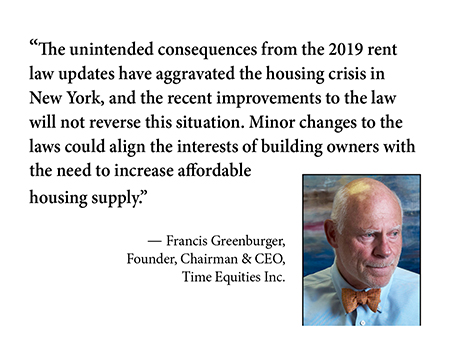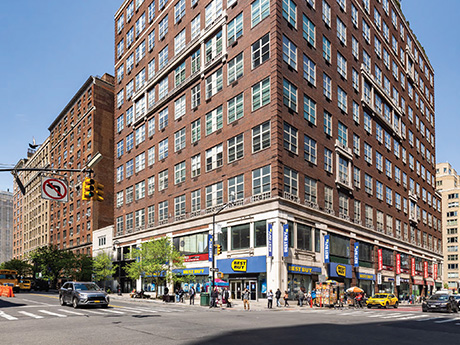“If you can make it in New York, you can make it anywhere.” Martin Scorsese, Frank Sinatra and Jay-Z probably weren’t thinking about brick-and-mortar retail real estate when they penned and recorded the iconic song lyric, but that doesn’t make the expression any less applicable to that particular subject. The notion of merchandisers, restaurateurs and entertainment operators needing a certain and precise combination of savvy, moxie and pizzazz to succeed in New York City isn’t so much new as it is resurrected. That’s because it’s only been a few years since the asset class was left for dead. But retail resiliency is now an established and proven narrative that underpins commercial real estate investment. “Brick-and-mortar retail is truly here to stay,” proclaims Beth Rosen, executive vice president at RIPCO Real Estate. “Over the years, retailers have gotten so much more savvy and are now entering into smarter deals. There’s a lot of positive sentiment about the sector, which has seen its share of ups and downs. Rents got really out of control at one point, and if the economy wasn’t strong, retailers didn’t survive. But now, it’s really more about partnerships between tenants and landlords.” Limited Options That said, owners …
Market Reports
By Joel Marcus, senior partner, Marcus & Pollack LLP COVID-19 and the government-ordered shutdown had immediate negative consequences for all types of real estate, and New York City’s tax valuations took this into account. Damage from the pandemic still weighs down property values today, compounded by cultural shifts that sapped demand for commercial properties. Fair market values have evolved to reflect pervasive vacancy, building obsolescence and the heightened cost of serving tenants that have abundant alternatives to choose from. At the same time, work-from-home practices reduce space requirements. Retailers, restaurants and hotels see half the foot traffic they once had from nearby office buildings, adding to ongoing pressure from e-commerce and other challenges to create excess vacancy, constrained rental streams and declining market values. Valuation for property taxation has not evolved, however, judging by the revaluation tax assessments the city’s Department of Finance is issuing. Revaluations ostensibly update taxable property values to current fair market value. Yet New York’s assessors habitually inflate valuations by applying pre-pandemic rental rates and vacancy assumptions, ignoring the rents landlords are actually collecting today and turning a blind eye to fundamental changes in demand for commercial space. Old thinking persists among these assessors, and it …
By Tom Kucharski, CEO of Invest Buffalo Niagara When Ralph Wilson selected Buffalo to be the home of the new Bills franchise in the American Football League in the 1950s, it was one of the nation’s 10 highest populated cities, making it a natural fit. However, a general shift around the country away from traditional manufacturing as a major base for economic activity, combined with a number of other factors, led to a decline in the city’s employment and population bases in the ensuing decades. Over the past 25 years, Buffalo has reversed that trend, emerging as a city on the rise. The region recently saw its first population growth in over 70 years, according to the 2020 census. That growth has been spurred by a diversification of the local economy, attracting businesses in industries such as advanced manufacturing, food processing and life sciences. Companies were especially enticed by the region’s low cost of doing business and affordable energy supplied by the nearby Niagara River. A key to maintaining that momentum has been Buffalo’s self-reinvestment, including massive redevelopment projects centered around reclaiming the city’s waterfront district. The first wave of these efforts began about a decade ago. Specifically, prior to …
By Taylor Williams The retail markets throughout the greater New York City area have been starving for more quality space in the post-pandemic era, with ground-up supply gains rarely hitting the market outside of obligatory inclusions within apartment buildings and highly curated clusters at mixed-use developments. According to JLL’s latest market report on New York City, as of the first quarter of 2025, there were approximately 200 availabilities across Manhattan’s “prime” retail submarkets — a record low. Average asking rents leapt 7.4 percent between the fourth quarter of 2024 and the ensuing period, settling at a rate of $577 per square foot. The report identified traditionally ritzy retail corridors and hotspots such as Fifth Avenue, Madison Avenue, SoHo and Times Square as recipients of the “prime” label, also designating the Williamsburg district in Brooklyn as one such area. So when well-located spaces formerly occupied by retailers that are now defunct or aggressively downsizing become available, they tend to draw major, immediate interest. “Expanding retailers have substantial opportunities to backfill big box and junior spaces vacated by bankrupt chains,” says Mitzi Flexer, managing director in the New York City office of national brokerage firm Bradford Allen. Flexer says that a notable …
By Maya Khan, managing director, CBIZ Between the pandemic and the advent of hybrid work, it’s been a challenging stretch for the New York City office market. But savvy investors see skies clearing as interest rates come down and more employers call workers back to the office. The stabilizing market also offers new opportunities for office-to-residential conversions, thanks to recently enacted state and city incentives. In fact, office buildings sold for such purposes accounted for 50 percent of all development sales in Manhattan in the first half of 2024, according to data from Ariel Property Advisors. In what follows, we’ll take a deeper dive into those trends and look at how some New York real estate leaders who spoke at CBIZ’s “Manhattan to Main Street” panel are taking advantage of the current environment. The event, held in the fall of 2024, focused on the trillions of dollars in commercial real estate debt that is set to mature before 2028 and broader economic factors influencing the New York real estate market; it drew 85 attendees from the local real estate community. Opportunity on the Upswing It’s no secret that the Big Apple’s office sector has taken a beating in the past …
By Jason Penighetti, Esq., and Carol Rizzo, Esq. of Forchelli Deegan Terrana Together with high rent and exorbitant property values, the real property taxes that fund necessary services in New York State make housing affordability a significant concern for low- and middle-income residents. To ensure a sufficient supply of affordable housing, the state must address the ad valorem levy, whereby taxes are derived from a property’s market value. This article examines the critical interplay between New York’s property tax policies and housing affordability. While some taxing mechanisms hinder the development and availability of affordable housing, adjustments and a few additions to those practices have the potential to promote the affordable sector. Exemptions, Incentives New York’s real property tax system supports a complex framework of entities that rely significantly upon property tax levies to generate revenue and fund their budgets. Property taxes, assessed at the local level, support essential services such as public schools, police departments, libraries, highways, fire districts, open space preservation, out-of-county college tuition and the New York State Metropolitan Transportation Authority, among others. To encourage the development of affordable housing and ease the burden that real property taxes can impose on developers and owners in the sector, New …
By Francis Greenburger, founder, chairman & CEO, Time Equities Inc. The recent changes to New York laws regarding rent-stabilized apartments, included in the 2024 budget legislation and signed into law by Gov. Kathy Hochul, are a step in the right direction. Unfortunately, the step is so small that the effect will be the same as standing still. Much of the initial commentary on 2024 housing law updates was about the so-called “good cause eviction” provisions, which have little to do with eviction but are instead a rebranding of rent control. In 2019, the legislature made significant changes to the rules governing rent-stabilized apartments. Most legislators who voted for this bill undoubtedly hoped to help New York State meet its affordable housing needs, but the opposite has happened. Thousands of low-cost, rent-stabilized apartments have since become vacant and remain so. Many of these apartments were occupied by tenants or families for 40 years or more. Apartments require capital investments periodically, and expectations for housing change dramatically over long periods. Renovating these units to meet modern standards requires significant investment, often mandated by housing code. Until the changes, building owners were willing to make these investments because they were permitted to increase …
By Taylor Williams Across Manhattan’s major retail corridors and pockets, leasing agents, operators and owners are all gaining greater clarity on what levels of rent various submarkets can bear and, by extension, how much spaces are truly worth. After three years of disruptions of the public health and financial variety — each devastating in its own right — a reset of sorts is a major windfall for the country’s largest and arguably most dynamic retail market. Closing deals is challenging enough when all parties are on the same page and the economy is stable. When markets are going through tumultuous phases of discovery in which perceived valuations of spaces fluctuate wildly, negotiations tend to flame out even more quickly — if they even get going at all. “A year ago in Manhattan, you could have two adjacent stores, and one might have been asking for $120 per square foot while the other wanted $220 per square foot,” says Chase Welles, partner at TSCG, an Atlanta-based brokerage and consulting firm that is active in New York City. “There’s certainly more definition relative to last year, and the range of asking rents in each submarket has narrowed.” “The market has become more …
By Pam Knudsen, senior director of tax compliance services, Avalara While the dust has scarcely settled from a landmark ruling in New York City resulting in a massive crackdown on short-term rentals (STRs), the full extent of the fallout from the decision has yet to be fully grasped by many — and perhaps even by the city itself. Under the terms of Local Law 18, a resolution that passed earlier this year, hosts and owners of short-term rentals, including Airbnb, are now subject to tighter and stricter regulations. These include limits on numbers of guests, requirements to register with the city and obligations to more closely monitor guest behavior, among other regulations. The effective ban on short-term rentals will have considerable consequences on local economies, and more than anyone, it’s small lodging businesses that stand to be impacted by the resulting wave. But to fully understand the major impact this ban has on small businesses, we must first acknowledge that STRs should rightly be considered small businesses themselves. Much like any other small business, STRs are required by most communities to be licensed, registered and compliant with tax collection and remittance. Furthermore, the hosts and managers behind STRs operate in …
By Taylor Williams The New York City retail market is currently functioning like an episode of The Price Is Right. Developers, investors, brokers and operators are all trying to attach fair values to rents and sales prices for spaces of all sizes and submarkets. But after a tumultuous period marked by a global pandemic and record inflation, followed by a string of severe interest rate hikes, accurately assigning those numbers is easier said than done — at least in some submarkets. According to data from JLL, at the end of the third quarter, the average rent throughout New York City was $290 per square foot, down 5.3 percent year over year. That figure represents an improvement from the second quarter of 2022, when rents posted a 12 percent decline on a year-over-year basis. In addition, JLL’s data shows that 58 new leases were signed in the third quarter. While that figure marks a decline of 13 percent from the second quarter, it also constitutes an increase of 7.4 percent on a year-over-year basis. These numbers suggest that after retail leasing and sales completely stagnated in 2020 due to an unprecedented public health crisis, the market corrected sharply in 2021 and …
Newer Posts











